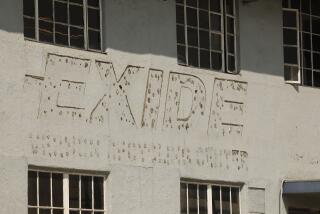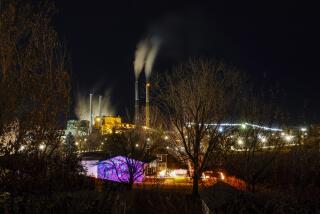Massive Pile of Tires Fuels Controversial Energy Plan
- Share via
WESTLEY, Calif. — For 20 years it has been building--a staggering pile of 40 million old tires, enough to fill a small valley in the barren foothills here 30 miles west of Modesto.
Now, in a controversial experiment being watched by public officials and energy firms across the nation, a private company has built and is testing a plant that will turn those old tires into electricity.
Burning tires like stove wood under a boiler, the incinerator consumes up to 900 tire carcasses an hour and produces 14 megawatts of electricity, enough energy to light up a small city of 15,000, about the size of Reedley or Sanger, in nearby Fresno County.
Stanislaus County officials view the plant as a way to eliminate the massive fire hazard posed by the tire pile, which has been likened to a volcano waiting to erupt. The builders of the plant, backed by a state bond issue, see it as a new source of energy.
Hazards Feared
But environmentalists and some area residents fear that the hazards of the plant have been inadequately assessed and that the operators are moving too slowly to eliminate the fire danger of the tire pile.
Oxford Energy Corp. of New York has just completed the $41-million project, in partnership with General Electric Co. The new plant, located on a hilltop near Interstate 5, is the first of its kind in the United States and the largest in the world.
The computerized furnaces operate at 1,800 degrees Fahrenheit, hot enough to destroy most of the polluting toxic wastes as well, county air pollution control experts said. Scrubbers, baghouse filters and other sophisticated equipment remove virtually all of the sulfur dioxides and other pollutants, they reported.
Fired up for the first time earlier this month, the plant is now undergoing shakedown trials before being tested to see if it meets state and county air quality protection standards.
Solid waste managers across the country are waiting and watching to see if this state-of-the-art tire-burner, with all of its high-tech, anti-pollution devices, is a practical way to get rid of discarded tires, which are virtually indestructible and are not biodegradable.
Every year Americans discard an estimated 250 million tires. Federal officials estimate 2 billion old tires are now piled in dumps throughout the country and warn that these tire heaps pose a public health threat because they are “excellent breeding grounds for mosquitoes.”
In addition, old tires are as combustible as coal, and once set ablaze quickly become an environmental nightmare, according to the Environmental Protection Agency. EPA experts reported a 1983 fire in a pile of 8 million tires near Winchester, Va., flamed out of control for weeks, sending up a pall of black smoke. In addition, the inferno chemically converted synthetic rubber into 250,000 gallons of boiling oil that spilled out of the blazing stack.
Toxics in Plume
Traces of heavy metals, benzine and other toxic chemicals were detected in the smoke plume, EPA chemist Robert Caron reported. However, he said the primary environmental hazards from the fire were cadmium pollution of the groundwater aquifers and the widespread fallout of the oily soot and ash.
Similar fires have burned in New Hampshire, Washington and Colorado. Most were set by arsonists, but a fire this summer in a pile of 2 million tires near Denver was caused by a lightning strike, government officials reported.
Several alternate-energy companies have proposed building tire-burning plants near other big tire piles throughout the nation, including a 30-megawatt incinerator in Rialto, in San Bernardino County. However, all of these projects are stalled by political wrangling over possible environmental impact evaluations and by the economics of this high-cost energy.
Power generated by plants such as the Oxford facility cost about seven cents a kilowatt hour, compared to one to two cents a kilowatt hour for hydroelectric or gas-fired steam generation, state energy and public utilities experts said. Pacific Gas and Electric Co. has contracted to buy Oxford’s higher-cost energy for 30 years, under terms set by a law passed during the 1970s oil crisis to encourage such development.
“Over the next decade, rate payers will pay enormous penalties for energy from plants like this,” said Arthur Winer, state Air Pollution Research Center scientist at the University of California, Riverside. Winer said society must weigh its need for waste disposal against the high cost of such plants and their environmental impacts. “These projects do add to air quality problems,” he said.
Stanislaus County officials acknowledged that the Oxford plant will add to the valley’s worsening air pollution problems, but said they have weighed the alternatives and believe that the emission controls built into the plant will keep the environmental impacts to acceptable levels.
The private tire dump here, known as the “Modesto Pile,” was started 20 years ago by Ed Filbin, who collects discarded tires throughout Northern and Central California. Filbin’s fleet of trucks are still hauling 10,000 to 20,000 tires a day into the deep canyon in the wrinkled foothills west of I-5, worried county officials said.
Filbin began trucking tires into Ed’s Tire Disposal even before construction of I-5. County officials said that when Filbin began, the area was remote and suitable as a dump site. Although the operation is now considered incompatible with current zoning and a fire hazard, county officials said they have no way to control the growing mountain of discarded rubber because the dump predates the current zoning.
In 1985, Oxford Energy leased land from Filbin and obtained a permit from the county to build the 14-megawatt generation plant, using technology developed by Gumi-MayerFilbin, in Landau, West Germany.
These days, Filbin is unavailable for comment.
Oxford Energy officials heard about the Modesto Pile three years ago and approached both Filbin and the county, proposing the tire-to-energy project. Filbin agreed to lease Oxford land for the plant and to supply the tires for the furnaces.
County officials said they would agree to the deal if the company would do three things: sharply reduce the inflow of tires to the dump, install extensive fire prevention systems immediately and eventually eliminate the huge dump altogether.
The company’s environmental consultants, Radian Corp. of Sacramento, looked at the fire potential and shook their heads.
“No one has ever had a tire pile that big catch on fire,” said James Rouge, the senior environmental consultant. “If it caught fire, it could take three to seven years to burn out . . . (and) would blacken the skies clear to Bakersfield,” 250 miles to the south.
Earthen dams and catch basins large enough to contain at least a million gallons of oil runoff are being built down-canyon from the pile, Stanislaus County Environmental Resources Director Gordon Dewers said. The company has also agreed to cut the huge mound into smaller units, leaving firefighting lanes between the stacks, he said. Oxford has already posted a 24-hour guard on the pile.
Oxford is buying Filbin’s tire collection business and has agreed to reduce the inflow of tires to the dump, starting Jan. 1. But getting rid of the stack itself will take time.
Mountain of Tires
With the furnaces roaring day and night, Oxford engineers said, it would take eight years for this West German-designed plant to burn its way through the mountain of tires.
However, to make the plant economically feasible, Oxford insists that it needs to continue importing some tires, while reducing the pile more slowly. The county agreed, giving the company 30 years to eliminate the dump and setting yearly reduction quotas.
The longer time period is needed for economic and competitive reasons, Oxford Vice President Gordon Marker said. He explained that the plant must have a guaranteed fuel supply to repay the construction debt that was financed by $38 million in interest-free, 30-year bonds sold by the California Alternate Energy Source Financing Authority.
Even though they will eventually use up the tires now piled in the dump, company officials said they will continue to keep a reserve of 1 million to 2 million tires on hand to guarantee a fuel supply. These reserves will be stored in several small piles, subject to fire controls.
Protesting Agreement
Opponents of the tire-burning project--unsuccessful in their initial attempts to block construction of the plant--are now protesting the agreement, saying the tire pile is a public nuisance and must be eliminated quickly.
“At the rate the county’s negotiated, they’ll burn 130 million tires in 30 years; that’s not a reduction,” said Gordon E. Hart, executive director of the Ecology Action Education Institute, a Modesto-based environmental group. Opponents have taken their complaints to the state attorney general’s office.
Deputy Atty. Gen. Kenneth Alex said he is considering abatement action, based on the ruling of a New Hampshire court that found a tire pile a third the size of this one posed an “unjustifiable and unreasonable risk” to public health and safety. Alex said he would like to see the size of the Modesto Pile quickly reduced.
Oxford officials argue that burning the pile down as fast as possible would be environmentally short-sighted.
“Northern California is generating 8 to 9 million tires a year,” Marker said. “Those tires will just get dumped somewhere else if we don’t burn them. . . . Economically it makes sense to combine the disposal, rather than use up the pile.”
More to Read
Sign up for Essential California
The most important California stories and recommendations in your inbox every morning.
You may occasionally receive promotional content from the Los Angeles Times.










